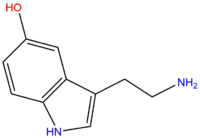Monoamine: Difference between revisions
>Dextromethorphan No edit summary |
>Dextromethorphan No edit summary |
||
| Line 1: | Line 1: | ||
[[Image:Serotonin.png|thumb|right|200px|[[Serotonin]] is a monoamine neurotransmitter]] | [[Image:Serotonin.png|thumb|right|200px|[[Serotonin]] is a monoamine neurotransmitter]] | ||
'''Monoamine neurotransmitters''' are [[neurotransmitters]] and neuromodulators that contain one amino (-NH<sub>2</sub>) group that is connected to an aromatic ring by a two-carbon chain (-CH<sub>2</sub> | '''Monoamine neurotransmitters''' are [[neurotransmitters]] and neuromodulators that contain one amino (-NH<sub>2</sub>) group that is connected to an aromatic ring by a two-carbon chain (-CH<sub>2</sub>CH<sub>2</sub>-). | ||
All monoamines are derived from aromatic amino acids like phenylalanine, [[tyrosine]], tryptophan, and the thyroid hormones by the action of [https://en.wikipedia.org/wiki/Aromatic_L-amino_acid_decarboxylase aromatic amino acid decarboxylase] [https://en.wikipedia.org/wiki/Enzyme enzyme]s. Monoaminergic systems, i.e., the networks of neurons that utilize monoamine neurotransmitters, are involved in the regulation of cognitive processes such as emotion, arousal, and certain types of memory. | All monoamines are derived from aromatic amino acids like phenylalanine, [[tyrosine]], tryptophan, and the thyroid hormones by the action of [https://en.wikipedia.org/wiki/Aromatic_L-amino_acid_decarboxylase aromatic amino acid decarboxylase] [https://en.wikipedia.org/wiki/Enzyme enzyme]s. Monoaminergic systems, i.e., the networks of neurons that utilize monoamine neurotransmitters, are involved in the regulation of cognitive processes such as emotion, arousal, and certain types of memory. | ||
Revision as of 04:00, 9 November 2016

Monoamine neurotransmitters are neurotransmitters and neuromodulators that contain one amino (-NH2) group that is connected to an aromatic ring by a two-carbon chain (-CH2CH2-).
All monoamines are derived from aromatic amino acids like phenylalanine, tyrosine, tryptophan, and the thyroid hormones by the action of aromatic amino acid decarboxylase enzymes. Monoaminergic systems, i.e., the networks of neurons that utilize monoamine neurotransmitters, are involved in the regulation of cognitive processes such as emotion, arousal, and certain types of memory.
It has been found that monoamine neurotransmitters play an important role in the secretion and production of neurotrophin-3 by astrocytes, a chemical which maintains neuron integrity and provides neurons with trophic support.[1] Drugs used to increase (or reduce) the effect of monoamine are sometimes used to treat patients with psychiatric disorders, including depression, anxiety, and schizophrenia.[2]
Examples
Tryptamine
Catecholamines
- Dopamine (DA)
- Noradrenaline (NA, NAd; Norepinephrine)
- Adrenaline (Ad; Epinephrine, Epi)
Other
References
- ↑ Regulatory role of monoamine neurotransmitters in astrocytic NT-3 synthesis | doi=10.1016/j.ijdevneu.2009.10.003
- ↑ The monoamine neurotransmitter disorders: An expanding range of neurological syndromes | doi=10.1016/S1474-4422(11)70141-7
- ↑ A glial variant of the vesicular monoamine transporter is required to store histamine in the Drosophila visual system | doi=10.1371/journal.pgen.1000245